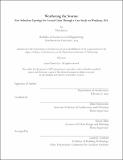| dc.contributor.advisor | Miho Mazereeuw and Kairos Shen. | en_US |
| dc.contributor.author | Lee, Hyerin,M. ArchMassachusetts Institute of Technology. | en_US |
| dc.contributor.other | Massachusetts Institute of Technology. Department of Architecture. | en_US |
| dc.coverage.spatial | n-us-ma | en_US |
| dc.date.accessioned | 2020-10-08T21:27:03Z | |
| dc.date.available | 2020-10-08T21:27:03Z | |
| dc.date.copyright | 2020 | en_US |
| dc.date.issued | 2020 | en_US |
| dc.identifier.uri | https://hdl.handle.net/1721.1/127849 | |
| dc.description | Thesis: M. Arch., Massachusetts Institute of Technology, Department of Architecture, May, 2020 | en_US |
| dc.description | Cataloged from PDF version of thesis. | en_US |
| dc.description | Includes bibliographical references (pages 61-62). | en_US |
| dc.description.abstract | Climate change is intensifying natural events around the world. As the sea level rises, coastal cities are becoming more vulnerable to storm surges and flooding. This is especially problematic in the U.S. where the population is concentrated and is on the rise along the coasts. Properties of high total value are also at risk. Various flood mitigation strategies have been implemented domestically and internationally. Hard solutions such as seawalls and levees can be effective but they are expensive and potentially catastrophic in the event of failure. Soft solutions like dunes and living shorelines have stabilizing effects but they are moderate in their effectiveness and will not protect against significant sea level rise or major storms. Strategies involving retreat is a sure way to remove people and properties from harm's way. If the sea level continues to rise, retreating will become inevitable. Currently, there are many challenges with this method. In the U.S., flood insurance policy is structured in a way to incentivize people to stay in flood-prone areas as opposed to moving. Relocation can be disorienting for people involved and costly for tax payers. Economic and political pressure often sides with building more than building less. This thesis aims at providing a design solution for coastal suburbs that can enable retreat in a sustainable way. Winthrop, Massachusetts, which is a dense suburb lying six miles to the east of Boston and is experiencing frequent flooding was selected as a case-study site. The thesis proposes a new building typology that can appeal to suburban life style, be implemented incrementally, and, most importantly, protect people and properties from the dangers of coastal flooding. | en_US |
| dc.description.statementofresponsibility | by Hyerin Lee. | en_US |
| dc.format.extent | 67 pages | en_US |
| dc.language.iso | eng | en_US |
| dc.publisher | Massachusetts Institute of Technology | en_US |
| dc.rights | MIT theses may be protected by copyright. Please reuse MIT thesis content according to the MIT Libraries Permissions Policy, which is available through the URL provided. | en_US |
| dc.rights.uri | http://dspace.mit.edu/handle/1721.1/7582 | en_US |
| dc.subject | Architecture. | en_US |
| dc.title | Weathering the storms : new suburban typology for coastal cities through a case study on Winthrop, MA | en_US |
| dc.title.alternative | New suburban typology for coastal cities through a case study on Winthrop, MA | en_US |
| dc.type | Thesis | en_US |
| dc.description.degree | M. Arch. | en_US |
| dc.contributor.department | Massachusetts Institute of Technology. Department of Architecture | en_US |
| dc.identifier.oclc | 1195903861 | en_US |
| dc.description.collection | M.Arch. Massachusetts Institute of Technology, Department of Architecture | en_US |
| dspace.imported | 2020-10-08T21:27:02Z | en_US |
| mit.thesis.degree | Master | en_US |
| mit.thesis.department | Arch | en_US |
